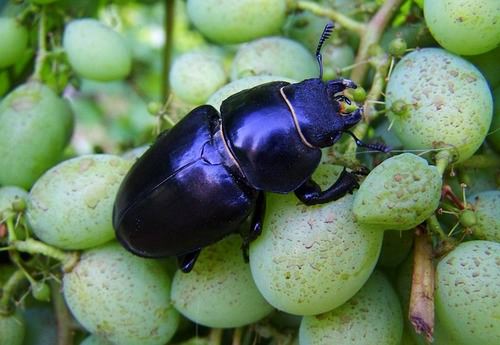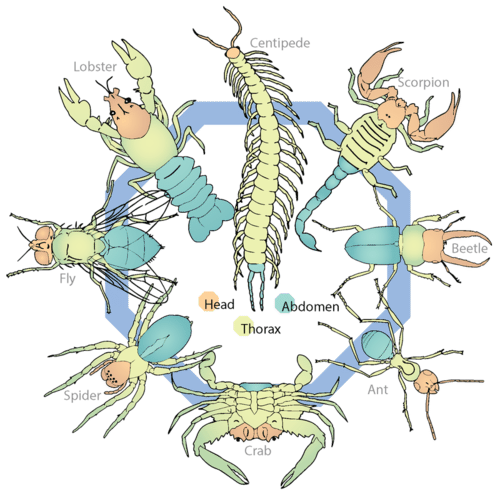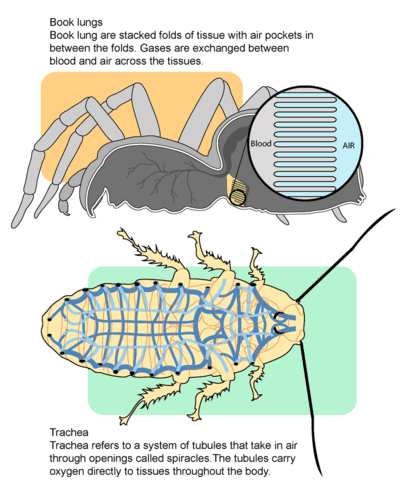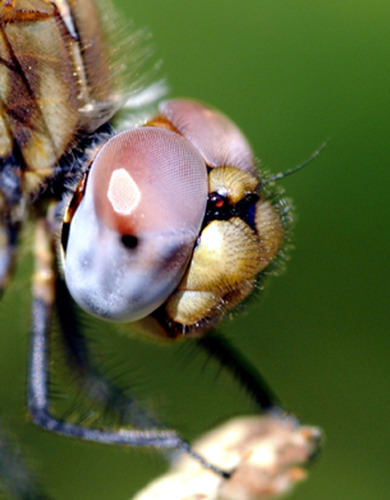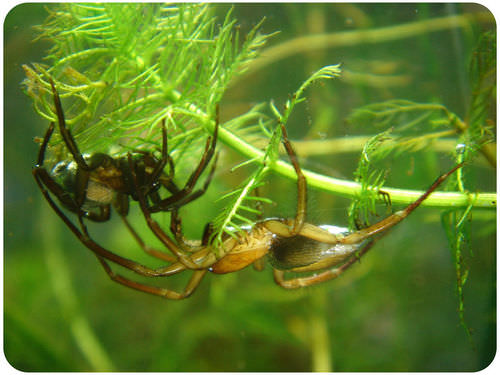15.30 Arthropod结构和功能 - 高级
章节大纲
-
Why a segmented body?
::为什么是分尸体?The body structure of this beetle is easily distinguishable. The three segments each have their own function and have led to the success of these organisms .
::这种甲虫的体结构很容易辨别,三个部分各有各自的功能,并导致这些生物体的成功。Structure and Function in Arthropods
::亚热带动物的结构和功能The great success of the is likely owed to the very features that make them unique, namely their segmented bodies, jointed appendages , and tough exoskeletons. In this section we will examine these characteristics in more detail. Then we will analyze the internal organ systems of arthropods, including their , , , and .
::之所以能够取得巨大成功,可能是因为这些特征使得它们具有独特性,即它们的分块体、联合附属体和坚硬的外骨干。在本节中,我们将更详细地研究这些特征。然后我们将分析节肢动物的内部器官系统,包括它们的器官系统。Segments and Exoskeleton
::片段和ExskeletonThe general body plan of arthropods is divided into three main regions:
::节肢动物总体计划分为三个主要地区:-
Head.
::头 -
Thorax.
::索拉克斯。 -
Abdomen.
::Abdomen. 腹部。 腹部。
These regions are called tagmata, and they are formed by groups of body segments that are either fused together or linked by joint tissue . Figure shows the overall body plan of arthropods.
::这些区域被称为 " tagmata " ,由混合或联合组织连接的身体部分组成。图显示了节肢动物的整体身体计划。Arthropod Body Plan. Notice the head, thorax, and abdomen segments of each organism. Arthropod Head. Arthropods have evolved a variety of specialized appendages and other structures on their heads. Generalized body plan of an arthropod. This diagram shows the three major tagmata of an arthropod: head, thorax, and abdomen. Notice that the tagmata consist of groups of segments and that the abdomen is divided into two subregions: the pleosome and the urosome. The specific name of each specialized appendage is indicated. The last region of the body is called the telson, and it is not considered a true segment. It forms the tail of the animal. The earliest arthropods have a set of appendages or limbs on each segment. More recently evolved , such as the bedbug, have a reduced number of appendages, and these appendages are often highly modified to carry out distinct functions. Some of these functions include the following:
::最早的节肢动物在每个部位上都有一套附肢或肢体。最近演化的病床等子宫数量减少,这些子宫往往经过高度修改,以履行不同的功能。其中一些功能包括:-
Feeding (mouthparts).
::进食(口袋)。 -
Sensing the environment (antennae).
::环境(天线)遥感。 -
Walking (legs).
::步行(腿)。 -
Swimming (paddle-like limbs).
::游泳(运动式肢体)。 -
Defending against
predators
and capturing
prey
(claws or fangs).
::保护捕食者和捕捉猎物(法律或刺牙)。
As mentioned earlier, the appendages of arthropods are distinct from those of in that they are jointed. In some species, the appendages are also branched, a condition called biramous. Unbranched appendages are called uniramous. Jointed appendages allow the much greater flexibility and range of movement . Imagine walking without bending your knees. It would be possible but very awkward and inefficient. Diagrams of uniramous and biramous arthropod limbs are shown in Figure .
::如前所述,节肢动物的附着物与结交的节肢动物的附附着物不同。在某些物种中,附附物也存在分支,一种叫两肢的情况。未割除的附附着物被称为无脊椎动物。联合附着物允许更大的灵活性和运动范围。想象在不弯曲膝下行走,这是可能的,但非常尴尬和低效。图中显示了无脊椎和双肢的图示。Uniramous versus biramous arthropod appendages. Uniramous appendages consist of sequential segments that do not branch. Biramous appendages have segments that branch off of each other. The arthropod exoskeleton is impermeable to , a feature that is key for survival on land. It consists of a multilayer cuticle composed of a complex called chitin , as well as and . The structure of the cuticle/exoskeleton is shown in Figure .
::节肢动物外骨骼是陆地生存的关键特征,它包括一个多层的切片,由称为Chitin的复合体组成,以及。 外骨骼/外骨骼的结构在图中显示。Structure of the cuticle/exoskeleton of arthropods. The cuticle components are labeled as follows: 1. Epicuticle 2. Exocuticle 3. Endocuticle 4. Epidermal cell layer 5. Basement membrane 6. Bristle-forming cell 7. Bristle socket 8. Bristle 9. Dermal gland 10. Dermal gland duct opening. There are many advantages to having a hard outer layer:
::具有硬外层有许多好处:-
Protection.
::保护。 -
Water retention.
::保留水。 -
Structural support (particularly on land).
::结构支助(特别是陆上结构支助)。 -
Counterforce for attachment and contraction of
.
::反依附和收缩...
However, there are also some limitations imposed by the exoskeleton. For one thing, it can severely limit the flexibility of the animal due to its rigid nature. Arthropods have partially alleviated this problem by having the exoskeleton form as individual plates on each body segment or individual cylinders on each segment of the appendages. The plates are called sclerites, and they are connected by flexible tissue to allow the animal to bend during movement. Many species also have an additional exoskeletal component called a carapace. This is a shield-like plate of exoskeleton that often forms over the thorax and head region. An example of a species with a carapace is shown in Figure .
::然而,外骨骼也有某些限制。 一方面,它会因其僵硬性而严重限制动物的弹性。 亚甲板类动物通过将外骨骼形态作为每个身体部位的单个板块或附属区段的单个圆筒部分,部分地缓解了这一问题。 外骨骼形态被称为刀片,它们通过软体组织连接,允许动物在运动中弯曲。 许多物种还增加了外骨骼成分,称为卡帕切。 这是外骨骼的盾牌板,通常形成在胸口和头部区域。 图中显示了带有卡帕的物种的例子。A species of crab. The shield-like covering on the top of this crab is the carapace, a modified plate of exoskeleton. Movement
::动 动Arthropods move using their appendages as legs on land and as paddles in environments. They have striated and smooth muscles , similar to those of vertebrates , that connect to the exoskeleton for support. Winged are also able to move by flying. Flight will be discussed in more detail in the Insects: Flight (Advanced) concept.
::Arthropods使用其附属物作为陆地上的腿和环境中的桨来移动,它们与脊椎动物的肌肉相似,有条纹和光滑的肌肉,它们与外骨骼相连接,需要支持。编队也可以通过飞行移动。飞行将在昆虫:飞行(高级)概念中更详细地讨论。Respiration and Circulation
::呼吸和流通Similar to annelids, arthropods are coelomates with a true coelom , or body cavity. However, in arthropods the coelom is reduced to a small compartment surrounding the reproductive and excretory organs . Like the you learned about in the Mollusks chapters, arthropods have an open circulatory system that consists of a dorsal and large body cavities called hemocoels. These blood-filled regions are the primary body cavities in arthropods. In an open circulatory system, the is only transported part of the way through the body within blood vessels. These vessels empty into the hemocoels, and blood must diffuse from there to reach tissues throughout the body. This is less efficient than a closed circulatory system in which blood is transported to all tissues of the body within blood vessels. In arthropods, the dorsal blood vessel runs along the dorsal, or top, interior of the body, and it consists of two major regions. The abdominal region is highly muscular and is considered the heart. It consists of a number of chambers that pump hemolymph (arthropod blood) collected from the hemocoel in the abdomen toward the head region. The hemolymph enters the heart through ostia, or pores, located on each chamber. The portion of the dorsal blood vessel that goes through the thorax is not muscular, and it is called the aorta . Hemolymph emerges from the aorta in the head region, and from there it re-enters the hemocoels and diffuses throughout the body to reach all tissues. Figure illustrates the internal anatomy of an arthropod with the dorsal circulatory system shown in red.
::与内脏相似, 节肢动物是具有真正骨髓或体腔的骨骼。 然而, 在节肢动物体内, 骨髓被切为生殖器官和排泄器官周围的小隔间。 就像你在摩洛萨斯各章中所学到的, 节肢动物有一个开放的循环系统, 由服体和大体腔组成, 叫做 hemocoels。 这些充血的区域是人工血管的主要血管腔。 在开放的循环系统中, 只有部分通过血液容器内的身体迁移。 这些血管被排入一个很小的隔绝。 这些血管必须从那里扩散到全身的组织。 这比一个封闭的循环系统效率要低, 血液被输送到血管内的所有组织。 在节肢动物体内, 口腔血管血管里的所有血囊和身体内部部位, 并且它由两个主要的血液组成。 这些血管部位的骨骼部部部部部部位, 血部部部部部部部和心脏部部部部部部, 血部部部部的血部部部部部部部部部部部部部部部, 向心脏部的血部部部部部部部部部部部部部部部部部部部部部部部位, 。 血部部部部, 血部部部部, 血部的血部部部部位, 血部部部部部部部部部, 血部部部部部位, 血部部, 血部, 血部, 血部部部部部部部部部部部部部部部, 血部部部部部, 血部部部部部部部部位, 向心脏部部部, 向心脏部部部, 向心脏部, 血部, 血部,血部,血部,血部,血部,血部,血部,血部,血部,血部,血部,血部,血部,血部,血部,血部,血部,血部,血部,血部,血部,血部,血部,血部,血部,血部,血部,血部,血部部,血部,血部部,血部,血部,血部,血部,血部,血部,Internal anatomy of an arthropod. The digestive system is shown in green, the circulatory system is shown in red, and the nervous system is shown in blue. The respiratory system of arthropods includes several different adaptations depending on the subgroup and habitat . Aquatic arthropods respire using gills that absorb oxygen from water. Some arthropods, such as spiders and scorpions, have book lungs to breath gaseous oxygen from the air. Book lungs are made up of stacks of folded tissue that have a large surface area for absorbing oxygen. Most other terrestrial arthropods have evolved an elaborate system of trachea that take in air and deliver it throughout many regions of the body.
::节肢动物的呼吸系统根据亚类和生境有几种不同的适应性。水生节肢动物利用吸收水氧的刺状呼吸。一些节肢动物,如蜘蛛和蝎子,有书本肺,可以吸入空气中的气态氧气。书本肺由折叠组织堆成,其表面积很大,可以吸收氧气。其他大多数地面节肢动物已经发展出一种精密的气管系统,吸收空气,在身体的许多区域传播。How Terrestrial Arthropods Breathe Air. Terrestrial arthropods have respiratory structures that let them breathe air: diagrams of the trachea and book lungs are shown here. There are essentially two types of excretory systems in arthropods:
::节肢动物基本上有两类排泄系统:-
Malphigian tubules.
::马尔菲吉的管子 -
Coxal glands
.
::考克斯尔腺
and some have an that uses coxal glands (also called green glands, antennal glands, or maxillary glands). Coxal glands consist of a sac that collects waste from the hemocoel, a tubule that facilitates the reabsorbtion of useful nutrients and the concentration of waste, and excretory pores. The pores are located at the base of the appendages. In contrast, most terrestrial species use Malphigian tubules for excretion . A diagram of a Malphigian tubule is shown in Figure . The waste collected in these tubules is not excreted directly out of the organism. Instead, it is delivered to the posterior end of the digestive tract to be eliminated through the anus. The evolution of Malphigian tubules was important for terrestrial arthropods to be able to efficiently regulate water and salt balance within their bodies.
::并且有些人使用coxal glands(也称为绿腺、天线腺、或最大草原)。Coxal glands 由从hemocoel收集废物的沙子组成,该沙子从hemocoel收集废物,这是一个管状体,方便有用营养物的再吸附和废物的集中,还有排泄孔。孔位于附属物的底部。与此形成对照,大多数陆地物种使用马尔菲吉亚管状体进行排泄。图中显示了Malphigian管状体的图。在这些管状体中收集的废物不是直接从生物体中排出。相反,它被送到通过肛门清除的消化道的外端。马尔菲吉管体的进化对于陆地节肢动物能够有效地调节其身体内的水和盐平衡非常重要。A diagram of a Malphigian tubule. This diagram illustrates how the tubule empties into the hindgut of the digestive tract. Nervous System
::神经系统The nervous system of arthropods is made up of two nerve cords running along the ventral, or bottom, interior surface of the organism. A series of ganglia are located on the nerve cords, typically one pair for each body segment. Arthropods are cephalized organisms meaning that they have a central brain that is located in a distinct head region. The head region also houses the mouth and some sensory organs. Immediately behind the brain is the subesophageal ganglion, which is composed of three pairs of fused ganglia. It controls the mouthparts, the salivary glands , and certain muscles in the head. The nervous system of a typical arthropod is shown in blue in the diagram above ( Figure ).
::节肢动物的神经系统由两根神经索组成,沿着有机体的腹部或底部表面运行,在神经索上有一系列的帮派,通常是每个身体部位的一对。甲状腺动物是气化有机体,这意味着它们有一个位于一个不同的头部区域的中央大脑。头部区域还包含口腔和一些感官器官。大脑后面是亚眼结膜,由三对有引信的帮派组成。它控制口部、唾液腺和头部的某些肌肉。典型的节肢动物的神经系统在上文图(图示)中以蓝色显示(图示 ) 。Many arthropods have well-developed sensory organs, including both simple and compound for and antennae that are used to “smell” or detect chemicals in the environment. Compound eyes are made up of many individual photoreceptor units that each form a portion of an image of the world around the organism. If you have ever looked through a kaleidoscope, then you have an idea of what the images seen with compound eyes may look like. Figure shows the compound eyes of a dragonfly. Arthropods also often have hair-like bristles on the surface of their abdomens that allow them to sense touch. This is important because it would be difficult for nerves on the body wall to sense touch through the rigid exoskeleton.
::许多节肢动物有发达的感官器官,包括简单和复合的感官器官和天线,用来在环境中“喷雾”或探测化学物质。复合眼睛由许多单个光受体单位组成,这些光受体单位构成有机体周围世界的图象的一部分。如果你曾经通过甘蓝透视镜检查过,那么你就会知道以复合眼睛观察的图像可能长得像什么。图显示的是龙蝇的复合眼睛。亚节肢动物在其腹部表面也经常有毛状的骨骼,让它们感知到触觉。这很重要,因为身体壁上的神经很难通过僵硬的外骨骼感触觉。The compound eyes of a dragonfly. Underwater Spiders
::水下蜘蛛In the ponds of northern Europe lives a tiny brown spider that spends its entire life underwater. But just like land spiders, it needs oxygen to breathe. So, how does this spider breath? Does it use book lungs? No. In fact, aquatic spiders, known as "diving bell spiders," have gills. Every so often, the spider leaves its underwater web to visit the surface and bring back a bubble of air that sticks to its hairy abdomen. It deposits the bubble into a little silk air tank. This "diving bell" is a gill that sucks oxygen from the water, allowing the spider to stay underwater for up to 24 hours.
::在北欧的池塘里, 一只小棕色蜘蛛生活在水下, 整个生命都花在水下。 但是就像陆地蜘蛛一样, 它需要氧气呼吸。 那么, 蜘蛛呼吸如何? 它使用书本肺吗? 不。 事实上, 水生蜘蛛, 被称为“ 潜水钟蜘蛛 ” , 有刺。 蜘蛛经常离开水下网络, 查看表面, 并带回一个气泡, 将气泡粘在毛发的腹部。 它把气泡放入一个小丝质空气箱里。 这个“ 潜水钟” 是一个从水中吸氧的刺, 让蜘蛛在水下停留长达24小时。A pair of diving bell (water) spiders. Summary
::摘要-
The general body plan of arthropods is divided into three main regions: the head, thorax, and abdomen.
::节肢动物的总体计划分为三个主要区域:头部、胸腔和腹部。 -
Some arthropods have modified appendages that have functions such as feeding, sensing the environment, walking, swimming, defending against predators, and capturing prey.
::一些节肢动物改变了附着物的功能,如喂食、感知环境、步行、游泳、抵御掠食动物和捕食猎物。 -
Jointed appendages allowed arthropods to have much greater flexibility and range of movement.
::联合附属物使节肢动物具有更大的灵活性和流动范围。 -
Advantages of having a hard outer layer are protection, water retention, structural support (particularly on land), and counterforce for attachment and contraction of muscles.
::拥有硬外层的好处是保护、蓄水、结构支持(特别是在陆地上)和抗力,以抵御肌肉的依附和收缩。 -
Like mollusks, arthropods have an open circulatory system that consists of a dorsal blood vessel and hemocoels.
::和软体动物一样,节肢动物有一个开放的循环系统, 由双层血管和肝脏组成。 -
Arthropods have two types of excretory systems: Malphigian tubes and coxal glands.
::节肢动物有两种排泄系统:两栖动物管和科毒腺。 -
The nervous system of arthropods is made up of two nerve cords running along the ventral, or bottom, interior surface of the organism.
::节肢动物的神经系统由两根神经索组成,沿着有机体的通风口或底部内部表面运行。
Review
::回顾-
List the three tagmata of arthropods.
::列出节肢动物的三张标签。 -
What evolutionary advantages did arthropods gain from jointed appendages?
::节肢动物从联合附着物中获得的进化优势是什么? -
What is one limitation of a hard exoskeleton? How have arthropods dealt with this problem?
::硬体外骨骼的局限性是什么?节肢动物是如何处理这一问题的? -
How is the coelom of an arthropod different from the coelom of a mollusk?
::节肢动物的卵巢与软体动物的卵巢有何不同? -
What kind of a circulatory system do arthropods have?
::节肢动物有什么样的循环系统? -
What are the hair-like bristles found on some arthropods used for?
::在一些节肢动物身上 找到的发型般的晶片是用来做什么的?
-
Head.
